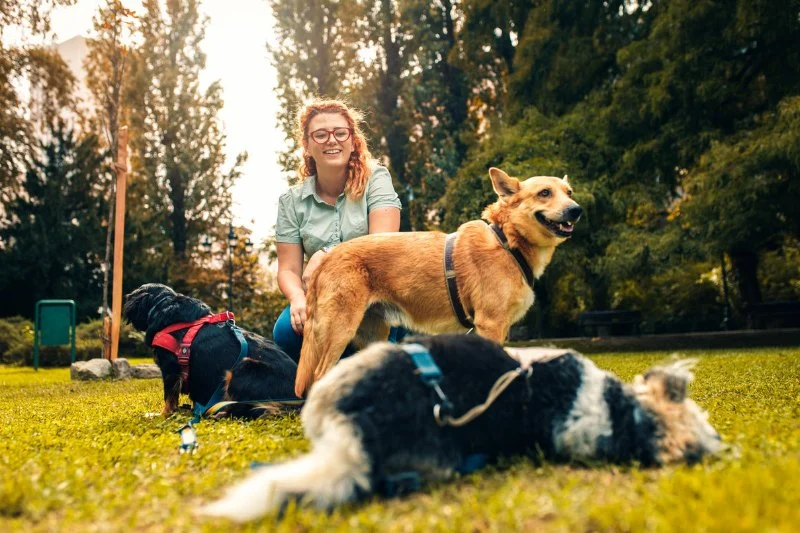
How to Train a Service Dog: Basics & Considerations
- Understanding Service Dogs
- Getting Started with Service Dog Training
- Key Skills Every Service Dog Should Learn
- Real-life Case: Training a Service Dog
- Choosing the Right Resources for Service Dog Training
A service dog is a specially trained animal that provides assistance to individuals with disabilities. Service dogs are not pets—they are working animals trained to perform specific tasks that help improve their handlers' quality of life. Whether it’s a guide dog for a blind person or a dog trained to alert someone with a medical condition, these dogs provide invaluable support. Training a service dog is a process that requires patience, consistency, and dedication. In this guide, we will explore the basics of training a service dog, the key skills they need to learn, and tips for successful training.

Noah's Animal Hospital & 24 HR Emergency Center
IndianapolisMarion CountyIndiana
5510 Millersville Rd, Indianapolis, IN 46226, USA
Getting Started with Service Dog Training
1. Assess the Needs of the Handler – Before beginning the training process, it's crucial to assess the specific needs of the person who will rely on the service dog. The tasks the dog will be trained to perform will depend on the handler’s disability. For example, a dog may need to retrieve items, provide balance support, or alert to medical conditions like seizures. Understanding these needs is the first step in creating a tailored training plan.
2. Choosing the Right Dog – Not every dog is suitable for service dog training. Typically, dogs that are calm, intelligent, and eager to please are good candidates. Breeds like Labrador Retrievers, Golden Retrievers, and German Shepherds are often chosen because of their temperament and trainability. However, it’s essential to ensure that the dog has the physical and mental capacity to handle the training demands.
3. Start Early – Service dog training ideally starts at a young age when the dog is more receptive to learning. However, older dogs can also be trained, though it may take a bit more time. Early socialization is key to helping the dog get comfortable with various environments, people, and situations they may encounter while working.
Key Skills Every Service Dog Should Learn
The training for a service dog involves teaching them specific skills that will help them assist their handlers in daily tasks. Here are some essential skills every service dog should learn:
1. Basic Obedience – A service dog must be well-behaved and obedient in various environments. Basic commands like “sit,” “stay,” “come,” and “heel” are essential for their safety and ability to assist effectively.
2. Task-Specific Training – This is the heart of service dog training. Dogs are taught to perform specific tasks such as guiding a blind person, retrieving items, providing physical support, or even alerting to an oncoming seizure. These tasks can be complex and require a significant amount of repetition and consistency.
3. Public Access Training – Service dogs must be able to behave appropriately in public places. This includes staying calm and focused in environments with distractions like busy streets, grocery stores, or airports. Public access training helps ensure that the dog can navigate public spaces safely and without disrupting others.
4. Socialization – It’s important for service dogs to be well-socialized with people, other dogs, and various environments. Proper socialization helps the dog remain calm and confident in new situations, which is essential when accompanying their handler to different places.
Real-life Case: Training a Service Dog
Take the case of Emily, who has mobility issues and required a service dog to help with tasks such as picking up dropped items and opening doors. Emily began by selecting a calm and intelligent Labrador Retriever named Max, who was about a year old. Max had already received basic obedience training, so Emily worked with a professional trainer to teach him the task-specific skills required for her needs.
Over several months, Max learned how to retrieve items, press automatic door openers, and help Emily maintain balance while walking. Emily took Max to various public places to ensure that he could remain calm and focused despite distractions. Today, Max is not just Emily’s service dog—he’s a trusted companion who has made a significant difference in her daily life.
Choosing the Right Resources for Service Dog Training
1. Professional Trainers – Working with a certified service dog trainer is crucial to ensure your dog receives the appropriate training. Trainers with experience in service dog tasks understand the importance of task-specific training and how to deal with behavioral issues that may arise during the process.
2. Training Materials – For those who prefer to train their service dog at home, there are various online courses, books, and videos available. It’s important to choose resources that are well-regarded and proven to be effective for service dog training.
3. Patience and Consistency – Service dog training is a long-term commitment. It requires patience, consistency, and dedication to ensure the dog is well-prepared to assist its handler. Regular practice and positive reinforcement are key to the dog’s success.
If you’re looking for high-quality products and services to support your service dog training, visit Pet & Puppy for top-rated training supplies, dog care products, and resources that will help you along the way.








 1214 Central Store0.0 (0 reviews)
1214 Central Store0.0 (0 reviews) Burlington Pet Hospital4.0 (118 reviews)
Burlington Pet Hospital4.0 (118 reviews) ArkVets4.0 (426 reviews)
ArkVets4.0 (426 reviews) Hartzell Veterinary Service: Charles W. Hartzell, DVM and Sue Ann Hartzell, DVM4.0 (105 reviews)
Hartzell Veterinary Service: Charles W. Hartzell, DVM and Sue Ann Hartzell, DVM4.0 (105 reviews) Noah's Ark Animal Hospital4.0 (163 reviews)
Noah's Ark Animal Hospital4.0 (163 reviews) Jasper Pet Clinic4.0 (285 reviews)
Jasper Pet Clinic4.0 (285 reviews) Transitioning Training Methods as Pet Ages: Adapting Techniques for Senior Pets
Transitioning Training Methods as Pet Ages: Adapting Techniques for Senior Pets How to Read & Understand Pet Nutrition Labels for Your Pet's Health
How to Read & Understand Pet Nutrition Labels for Your Pet's Health How to Choose the Right Pet Supplement Brand: Essential Tips for Pet Owners
How to Choose the Right Pet Supplement Brand: Essential Tips for Pet Owners How Much Should You Feed Your Pet? Portion Guide by Age & Breed
How Much Should You Feed Your Pet? Portion Guide by Age & Breed How to Create a Pet Health Journal: Metrics to Track for Better Pet Care
How to Create a Pet Health Journal: Metrics to Track for Better Pet Care What Breed-Specific Health Issues You Should Be Aware Of
What Breed-Specific Health Issues You Should Be Aware Of